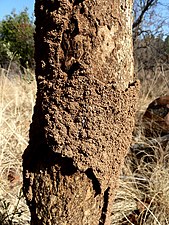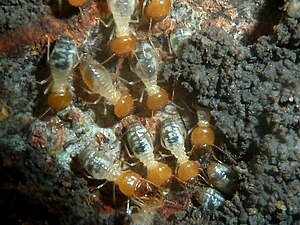
Termites are a group of detritophagous eusocial insects which consume a wide variety of decaying plant material, generally in the form of wood, leaf litter, and soil humus. They are distinguished by their moniliform antennae and the soft-bodied and often unpigmented worker caste for which they have been commonly termed "white ants"; however, they are not ants, to which they are distantly related. About 2,972 extant species are currently described, 2,105 of which are members of the family Termitidae.
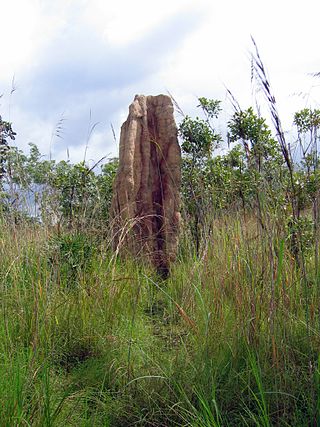
Mound-building termites are a group of termite species that live in mounds which are made of a combination of soil, termite saliva and dung. These termites live in Africa, Australia and South America. The mounds sometimes have a diameter of 30 metres (98 ft). Most of the mounds are in well-drained areas. Termite mounds usually outlive the colonies themselves. If the inner tunnels of the nest are exposed it is usually dead. Sometimes other colonies, of the same or different species, occupy a mound after the original builders' deaths.

Termitomyces, the termite mushrooms, is a genus of basidiomycete fungi belonging to the family Lyophyllaceae. All of which are completely dependent on fungus-growing termites, the Macrotermitinae, to survive, and vice versa. They are the food source for these termites, who enjoy an obligate symbiosis with the genus similar to that between Atta ants and Attamyces mushrooms. Termitomyces mushrooms are edible, and are highly regarded for their flavor.

Fungivory or mycophagy is the process of organisms consuming fungi. Many different organisms have been recorded to gain their energy from consuming fungi, including birds, mammals, insects, plants, amoebas, gastropods, nematodes, bacteria and other fungi. Some of these, which only eat fungi, are called fungivores whereas others eat fungi as only part of their diet, being omnivores.

The Macrotermitinae, the fungus-growing termites, constitute a subfamily of the family Termitidae that is only found within the Old World tropics.

Termitomyces reticulatus is a species of agaric fungus in the family Lyophyllaceae. Found in southern Africa, it was described as new to science in 1990. It is associated with the termite species Odontotermes badius and O. transvaalensis, which are widely distributed in South Africa.

Termitomyces heimii is a species of agaric fungus in the family Lyophyllaceae. It has symbiotic relationship with termites. Described as new to science in 1979, it is found in India. The specific epithet heimii honors French mycologist Roger Heim. The fruit bodies (mushrooms) produced by the fungus are edible.

Macrotermes bellicosus is a species of Macrotermes. The queens are the largest amongst known termites
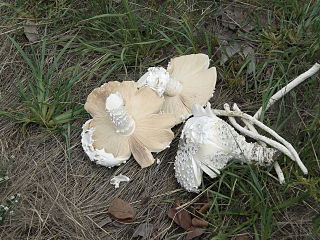
Termitomyces schimperi is a large mushroom associated with the termite species Macrotermes michaelseni. It grows in the northern part of Southern Africa, from northern Namibia up to Democratic Republic of Congo (DRC), eastwards to Malawi and Mozambique, and westwards to Ivory Coast.

Termitotrox cupido is a species of scarab beetle in the subfamily Termitotroginae. It was first described by Munetoshi Maruyama in 2012, having been discovered living inside a nest of the termite Hypotermes makhamensis in Cambodia. It is a tiny, blind and flightless insect.
Hypotermes makhamensis is a species of termite in the subfamily Macrotermitinae of the family Termitidae. It lives in dry evergreen forests in tropical south-eastern Asia and builds termite mounds in which it cultivates fungus for use as food.

Macrotermes michaelseni is a species of termite in the family Termitidae, found in sub-Saharan Africa. It is associated with the fungus Termitomyces schimperi.

Macrotermes is a genus of termites belonging to the subfamily Macrotermitinae and widely distributed throughout Africa and South-East Asia. Well-studied species include Macrotermes natalensis and M. bellicosus.
Odontotermes redemanni, is a species of termite of the genus Odontotermes. It is native to India and Sri Lanka. It damages wooden constructions. It is a pest of sugarcane, tea and coconut. They construct termitaria during November to March when rainfall and ambient temperature become low. Underground termite nests of this species are a natural host for the important Traditional Chinese Medicine fungus Xylaria nigripes, also known as Wu Ling Shen.

Macrotermes carbonarius, also known as Kongkiak in Malay, is a large black species of fungus-growing termite in the genus Macrotermes. It is one of the most conspicuous species of Macrotermes found in the Indomalayan tropics, forming large foraging trails in the open that can extend several metres in distance. M. carbonarius is a highly aggressive species with the soldiers possessing large curving mandibles that easily break skin. It is found in Cambodia, Malaysia, Myanmar, Singapore, Thailand and Vietnam.

Termitomyces eurrhizus species of agaric fungus in the family Lyophyllaceae native to Pakistan, India, Sri Lanka, Burma, southwestern China and Malaysia. The fungus has a symbiotic relationship with termites, its mushrooms growing out of mounds after periods of rainfall. It is eaten in Malaysia and the Indian subcontinent.

Macrotermes natalensis is a fungus-growing termite species that belongs to the genus Macrotermes. This species is associated with the Termitomyces fungal genus. M. natalensis has domesticated Termitomyces to produce food for the colony. Both termite species- fungal genus- are obligate and mutually beneficial where termite relies on the fungus to break down for plant materiel and nutrient resource. In contrast, the fungal species obtain plant material and optimal conditions for growth.

Odontotermes obesus is a species of termite in the family Termitidae. It is native to tropical southwestern Asia. This termite cultivates a symbiotic fungus in a special chamber in the nest. Workers gather vegetable detritus which they bring back to the colony, chewing up the material to make a suitable substrate on which the fungus will grow.

Syntermes is a genus of large Neotropical higher termites within the subfamily Syntermitinae. The genus is found only in South America where members are distributed widely throughout the continent, being found from the tropical rainforests of Colombia to the savannas of Brazil and Northern Argentina.
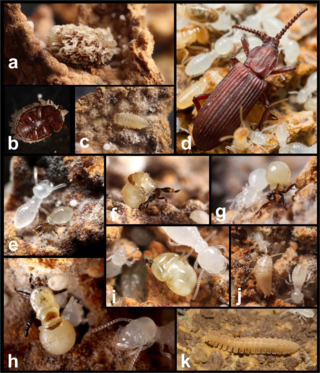
Odontotermes formosanus is a species of fungus-growing termite in the family Termitidae. It is native to southeastern Asia and was first described from Taiwan. This termite cultivates a symbiotic fungus in a special chamber in the nest. Workers and soldiers gather vegetable detritus which they bring back to the colony, chewing the material to a pulp to make a suitable substrate on which to grow the fungus.


